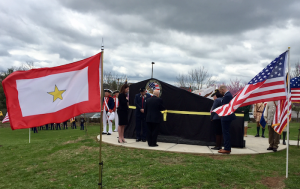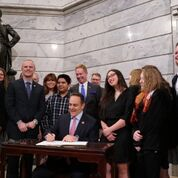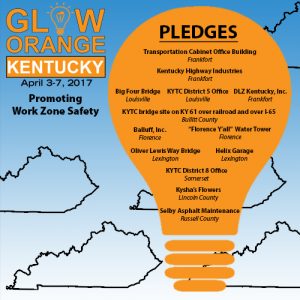 Secretary of State Alison Lundergan Grimes on Tuesday participated in the dedication of a memorial monument honoring fallen military service members and their families. Grimes and other state and city leaders led the ceremony to unveil the Gold Star Families Memorial Monument at Veterans Park in Lexington.
Secretary of State Alison Lundergan Grimes on Tuesday participated in the dedication of a memorial monument honoring fallen military service members and their families. Grimes and other state and city leaders led the ceremony to unveil the Gold Star Families Memorial Monument at Veterans Park in Lexington.
“Today, we honor the ultimate sacrifice of men and women who stood up and served courageously so that we could live freely,” said Grimes. “And we know that not only have these individuals sacrificed, but so have their families. For that, we are eternally grateful.”
The monument is the 18th of its kind in the nation and the third in Kentucky. The Hershel “Woody” Williams Congressional Medal of Honor Education Foundation assists communities in raising funds and establishing the monuments, including Lexington’s. Williams joined Grimes in the dedication.
As Secretary of State, Grimes has been a steadfast advocate for active military and veterans. Her recommendations to improve military voting resulting from a trip to the Middle East were made law as the first-ever Military Heroes Voting Initiative. The initiative led to a nationally-recognized portal which has successfully assisted thousands of Kentucky military and overseas citizens to cast ballots in elections.
In 2014, Grimes helped several veterans and advocates establish the Kentucky Veterans Hall of Fame, which honors Kentucky military veterans who have demonstrated exemplary military service as well as military/civilian service to their communities, state, and nation.
Grimes recently pushed for “Boots to Business” legislation in Kentucky’s General Assembly to help veterans start and grow businesses in Kentucky.
“As long as I am able, I will be fighting for those who have fought for us and the families of those who have died for us,” Grimes said.
 Kentucky students are much more media literate than they are given credit for, said Bighill media artist Bob Martin. Martin is a teaching artist in the media arts category in the Kentucky Arts Council’s adjudicated Teaching Artists Directory.
Kentucky students are much more media literate than they are given credit for, said Bighill media artist Bob Martin. Martin is a teaching artist in the media arts category in the Kentucky Arts Council’s adjudicated Teaching Artists Directory.
“They want to be witnessed. They have a lot to offer regarding how they see our society,” Martin said. “Just about every young person has a camera in their pocket. Storytelling through social media is a wonderful opportunity to engage them.”
Those opportunities will become plentiful with more media artists to share their knowledge and experience, he said. To achieve that, the arts council is looking for media artists to add to the council’s Teaching Artists Directory.
“Media, by definition, is the plural of medium, and it’s through using multiple media that are evolving, adapting and unfolding that we get our stories across,” Martin said. “It’s up to us to fill the need of students for media art instruction, and help young people engage critically with art through media.”
Martin, who works regionally in theater and film, has been a teaching artist in the directory for about three years. Bringing media arts lessons to Kentucky students through the residencies offered through the arts council’s Teaching Art Together program is a source of satisfaction for him, and he said he thinks his fellow media artists will find the same level of fulfillment.
“I believe in the state creating spaces for artists to be able to make a difference in their communities as performing or teaching artists,” Martin said. “It’s a valuable use of state resources to say we value artmaking, creation and creative visioning as an investment strategy. I appreciate participating in that.”
The application deadline for the Teaching Artists Directory is April 13.
For more information or to apply, visit the Teaching Artists Directory program page of the arts council website, or contact Jean St. John, arts council education director, at jean.stjohn@ky.gov or 502-892-3124.
The Kentucky Arts Council, the state arts agency, fosters environments for Kentuckians to value, participate in and benefit from the arts. Kentucky Arts Council funding is provided by the Kentucky General Assembly and the National Endowment for the Arts.
Last week, Gov. Matt Bevin ceremonially signed two pieces of recently enacted legislation that will improve the lives of children removed from their homes because of abuse or neglect.
House Bill 180 allows youth to be temporarily placed with non-relative adults who already have a significant emotional relationship with the child. House Bill 192 allows foster children to obtain their learner’s permits and driver’s licenses without the signature of their parent or guardian.
 “These new laws will help to restore some much-needed normalcy to the lives of Kentucky foster youth,” said Gov. Bevin. “But today is about more than simply restoring normalcy. It’s about respect. It’s about dignity. And it’s about creating opportunity.”
“These new laws will help to restore some much-needed normalcy to the lives of Kentucky foster youth,” said Gov. Bevin. “But today is about more than simply restoring normalcy. It’s about respect. It’s about dignity. And it’s about creating opportunity.”
Rep. Addia Wuchner, chairwoman of the House Health and Family Services Committee and primary sponsor of HB 180, noted that her bill provides adults with a family-like relationship to children the chance to play a larger role in their lives and gives the Cabinet for Health and Family Services (CHFS) and the courts another—less traumatic—option when children have to be removed from their homes.
“We all grew up with someone—a coach, a neighbor, a teacher, a friend’s parent or neighbor whose positive influence on us helped to guide us into maturity,” said Rep. Wuchner. “Sometimes those individuals are just like family and the closest thing to parents that kids have. In circumstances when a child is removed from a home, they can be a saving grace—a stabilizer that keeps a child from entering foster care and a series of tough transitions. ‘Fictive kin,’ as they are called, can be lifesavers. I am extremely proud that Gov. Bevin has such a commitment to Kentucky’s children, and I appreciate his support in signing this bill into law and his efforts to strengthen all families of the Commonwealth.”
Rep. Larry Brown, who was primary sponsor of HB 192, said that for too long, learning to drive has been one of many obstacles foster children face.
“At the point they are in out-of-home care, foster children have gone through so much trauma,” said Rep. Brown. “This new law will make life easier for them as they can apply for their driver’s licenses just like any other teenager. Foster kids have been asking for this for years. Thankfully, this legislature and this administration are listening to them.”
CHFS, the agency that administers the state’s adoption and foster care programs, says that almost 8,000 children are in state custody; and of these, more than 6,000 are in a foster care placement.
Cabinet Secretary Vickie Yates Brown Glisson noted that these new laws are part of the state’s overall commitment to transforming adoption and foster care programs.
“Gov. and First Lady Bevin are leading the charge to make life better for vulnerable children in Kentucky,” said Sec. Glisson. “We are truly all working together as a team to ensure all children in the Commonwealth are safe, cared for and loved.”
Glenda Wright, a former foster child and current president of Voices of the Commonwealth (an advocacy group of both present and former foster youth) said that she knows firsthand the struggles to fit in as a foster child.
“As a child without a permanent family, you already feel remarkably different from the other kids,” said Wright. “These new laws can give children in out-of-home care both the sense of security that comes from a loving home and the promise of independence that comes with growing up. I appreciate Gov. Bevin and the legislators who made these new laws a reality.”
Gov. Bevin has pledged to improve the state’s adoption and foster care system by mobilizing a network of nonprofits, faith-based organizations and loving families through his “Open Hearts/Open Homes” initiative.
For details about how you can become a foster or adoptive parent or to obtain general information, please visit adopt.ky.gov or contact the Commonwealth at openhearts@ky.gov or 1-800-232-KIDS (5437).

2017 “Glow Orange, Kentucky!” Pledge Map
Focusing on the human aspect surrounding highway work zone safety, the Kentucky Transportation Cabinet (KYTC) launched its state work zone safety campaign this week in conjunction with National Work Zone Awareness Week (NWZAW), April 3-7. The 2017 national theme – Work Zone Safety Is In Your Hands – reinforces the message that work zone safety is a shared responsibility for work crew members and motorists.
“Kentucky transportation road crews risk their lives daily to build and maintain bridges and roads across the Commonwealth so that we all can connect with people and places that are important to us,” said Gov. Matt Bevin. “As a young man, I worked for a state highway department and know about the dangers presented to men and women doing their jobs in highway work zones. These public servants are fathers, husbands, brothers, daughters and friends. Let’s all do our part to take precautions to make sure these highway workers – real people with real lives – get home safely each night.”
With roadway construction season kicking off in April across Kentucky, many motorists will encounter at least one work zone in their daily commute. Although highway work zones are high-risk sites for crew members, the lives of drivers and their passengers are also on the line in a work zone. In fact, Federal Highway Administration statistics indicate that motorists, not workers, are more at risk in a work zone. In a typical five-day work week, an average of seven motorists and one worker are killed around the nation in work zones. To help spread awareness, Gov. Bevin signed a proclamation declaring April Work Zone Safety Month in Kentucky.
Real stories, real people
Last year, there were 674 work zone related crashes, 143 injuries and 10 fatalities in Kentucky. To increase awareness of work zone safety and the lives affected by preventable accidents, KYTC asked the public to support this year’s campaign through sharing work zone stories. Retellings of near misses while working, losing loved ones in work zones and observations of negligent driving behavior were featured in several submissions. Each story stressed the risk of working in a work zone and the lives at stake.
“When he died, a piece of me died also – a void that you can’t replace,” wrote Tonya Ashby about her brother Kendale T. Ashby, who was hit by a car in 2014 while working in an active highway work zone.
Kendale Ashby was a father of four, a husband, a brother and a best friend.
“The Cabinet is grateful for public support in the form of personal stories and pledges from public and private partners to ‘Glow Orange’ to promote work zone awareness,” said KYTC Secretary Greg Thomas. “The safety of our road crews and of motorists in work zones is in each of our hands.”
Orange hues in the Bluegrass
Another element of KYTC’s 2017 work zone awareness campaign is “Glow Orange, Kentucky” week, an initiative inspired by the national “Go Orange Day,” which also promotes work zone awareness. KYTC has invited organizations and citizens throughout the Commonwealth to illuminate buildings, landmarks, bridges, structures and homes with the color orange to show support during the week of April 3-7.
The Cabinet encourages the public to submit “Glow Orange, Kentucky” safety selfies taken in front of illuminated structures to Facebook and Twitter using #glowky. Businesses and agencies that have pledged to “Glow Orange” are featured on KYTC’s social media pages.
Lives in your hands
For the protection of all lives in work zones, KYTC asks drivers to practice 10 work zone safety tips:
1. Pay attention – put away the phone.
2. Respect the posted speed limits – even if workers do not appear to be present.
3. Don’t tailgate.
4. Keep a safe distance from workers and equipment.
5. Expect the unexpected.
6. Obey road crew flaggers.
7. Allow extra time to get to your destination if traveling through a work zone.
8. Keep up with traffic flow.
9. Before leaving home or work, check out goky.ky.gov or use the free WAZE app for traffic information.
10. Be patient and remain calm. Construction crews are working to make the roads better for you.
Although Cabinet engineers and contractors schedule work to minimize delays and crashes, the responsibility to drive cautiously through a work zone lies with motorists.
To read work zone stories and stay current with KYTC’s 2017 work zone awareness campaign, connect with the Cabinet at www.facebook.com/kytc120/ and https://twitter.com/KYTC and follow the #inyourhandsky and #glowky discussions. The Cabinet will post related information to social media throughout the month of April.
 Kentucky placed second nationally in economic development projects per capita last year and first in the South Central region according to Site Selection magazine, Gov. Matt Bevin announced earlier this month.
Kentucky placed second nationally in economic development projects per capita last year and first in the South Central region according to Site Selection magazine, Gov. Matt Bevin announced earlier this month.
The rankings – part of Site Selection’s annual Governor’s Cup awards – make 2016 the third consecutive year Kentucky has placed first or second in the per-capita competition. Numerous Kentucky metropolitan and micropolitan regions also placed on top-10 lists for their economic development achievements. As well, Kentucky ranked seventh nationally in total projects, beating out states of far greater size.
“Kentucky continues to distinguish itself as a top location for new business growth and expansion,” Gov. Bevin said. “The strong performance outlined in this report stands as further proof of this fact, ranking us among the top 10 states by total economic projects announced. This is a great achievement for a state much smaller than many of our competitors, and is a testament to the efforts of thousands of people. It is exciting to see what happens when city, county, regional, state and federal levels collaborate to attract growth in communities across the commonwealth. The incredible beauty, quality of life, work ethic and abundant opportunities in Kentucky are becoming increasingly well known, and the future is bright indeed.”
In addition to the state’s high ranking, Site Selection named five Kentucky communities among its Top 10 Metro Areas Ranking. These include the Northern Kentucky/Cincinnati region, which ranked fifth among areas with populations exceeding 1 million; Lexington, which ranked fourth for communities with populations between 200,000 and 1 million; and Bowling Green, Owensboro and Elizabethtown, which placed second, seventh and ninth, respectively, among metropolitan areas with fewer than 200,000 people.
Kentucky also ranked fourth in total projects in micropolitan areas and 11 of its communities placed on the magazine’s 2016 Top Micropolitans list, including:
- Bardstown – Nelson County, 7th
- Danville – Boyle and Lincoln counties, tied for 9th
- Mayfield – Graves County, tied for 18th
- Frankfort – Franklin County, tied for 32nd
- Richmond-Berea – Madison County, tied for 32nd
- London – Laurel, Knox and Whitley counties, tied for 51st
- Maysville – Mason County, tied for 51st
- Somerset – Pulaski County, tied for 51st
- Glasgow – Barren and Metcalfe counties, tied for 78th
- Madisonville – Hopkins County, tied for 78th
- Mt. Sterling – Bath, Menifee and Montgomery counties, tied for 78th
Additionally, Paducah earned 10th place in total projects in communities along the Mississippi River Corridor.
“Our local economic development partners statewide share credit for this success. Their dedication to a team approach helps make Kentucky such a strong player,” said Terry Gill, secretary of the Kentucky Cabinet for Economic Development. “Considering the showing by 11 of our micropolitans and five metros, Kentucky owns a winning formula for attracting, retaining and growing businesses. As we apply that formula in the coming years, we’ll continually hone our approach to maintain our leading edge.”
Last year, Kentucky announced more than 310 new location and expansion projects. Those are expected to create more than 16,000 jobs and over $3.1 billion in investment. Site Selection counts 231 of those projects toward its rankings. For inclusion in the magazine’s database, qualifying projects must meet one or more of these criteria: a minimum capital investment of $1 million, 20 or more new jobs created, and 20,000 or more square feet of new space.
Site Selection, an Atlanta-based publication, has awarded the Governor’s Cup annually since 1988 to the US state with the most new and expanded corporate facilities as tracked by the Conway Projects Database.
Corporate real estate analysts regard the rankings as an industry scoreboard. The magazine’s circulation reaches 48,000 executives in corporate site selection decision making.
The full rankings can be viewed at www.siteselection.com.
Kentucky’s seasonally adjusted preliminary unemployment rate for February 2017 was down 0.1 percent from the January 2017 rate of 5.0 percent, according to the Office of Employment and Training (OET), an agency of the Kentucky Education and Workforce Development Cabinet.
The preliminary February 2017 jobless rate was 0.3 percentage points lower than the 5.2 percent rate recorded for the state in February 2016.
The U.S. seasonally adjusted jobless rate for February 2017 was 4.7 percent, according to the U.S. Department of Labor.
Labor force statistics, including the unemployment rate, are based on estimates from the Current Population Survey of households. It is designed to measure trends rather than to count the actual number of people working. It includes jobs in agriculture and those classified as self-employed.
In February 2017, Kentucky’s civilian labor force was 2,044,119 an increase of 18,982 individuals compared to the previous month. Employment was up by 19,092 and the number of unemployed decreased by 110.
“In February, our labor force increased by 0.9 percent,” said Kentucky Labor Market Information Director Kate Shirley Akers, Ph.D. “And over the last year, Kentucky’s employment has increased by 3.3 percent.”
In a separate federal survey of business establishments that excludes jobs in agriculture and people who are self-employed, Kentucky’s seasonally adjusted nonfarm employment increased by 1,900 jobs in February 2017 compared to January 2017.
“Overall, nonfarm employment has increased by 26,400 positions, or 1.4 percent from one year ago,” said Akers. “The largest month-to-month gain in jobs was in the construction sector.”
Nonfarm data is provided by the Bureau of Labor Statistics’ Current Employment Statistics program. According to this survey, five of Kentucky’s 11 major nonfarm North American Industry Classification System (NAICS) job sectors registered gains in employment, while six declined from the previous month.
The construction sector saw the largest month-to-month increase in February 2017, growing by 2,800 positions, or 3.5 percent, from a month ago. Since February 2016, this industry has added 4,700 jobs, growing by 6.1 percent.
Kentucky’s professional and business services also registered gains, increasing by 2,700 positions from January 2017. This sector has added 5,700 jobs, growing 2.6 percent, from February one year ago. This category includes establishments engaged in services that support the day-to-day activities of other organizations, including temporary employment services and payroll processing.
“The month to month gains in professional and business services was driven by growth in administrative and support and waste management and remediation services, which added 1,600 jobs, as well as increases in professional, scientific and technical services, which gained 1,000 positions,” said Akers.
Employment in the educational and health services increased by 800 jobs in February and has gained 4,100 positions over the year. This year to year increase was driven by job gains in health care and social assistance. Health care and social assistance jobs, which account for 12 percent of all nonfarm employment in Kentucky, increased by 1.7 percent from February 2016 to February 2017.
Employment in the other services sector, which includes repairs and maintenance, personal care services, and religious organizations, increased by 400 positions in February 2017 compared to a month ago. Over the year, the sector has added 1,000 positions, growing 1.5 percent.
The mining and logging sector added 100 jobs in February 2017 from a month ago. The industry has declined by 1,700 positions from a year ago.
Employment in the information sector declined by 100 positions in February 2017, but gained 1,100 from February one year ago. The industries in this sector include traditional publishing as well as software publishing; motion pictures and broadcasting; and telecommunications.
The leisure and hospitality sector lost 300 positions in February 2017 from a month ago. Since February 2016, the sector has added 700 jobs. This sector includes arts, entertainment, recreation, accommodation, and food services.
Kentucky’s manufacturing sector declined, decreasing by 500 positions from January 2017 to February 2017. Since February 2016, this sector has grown by 2.5 percent, expanding by 6,200 jobs.
The financial activities sector lost jobs in February 2017, declining by 500 positions from January 2017. This category includes establishments engaged in finance and insurance as well as real estate, rental and leasing. Since February 2016, however, the sector added 1,500 jobs, an increase of 1.6 percent.
Kentucky’s trade, transportation, and utilities also registered losses, decreasing by 1,200 positions over the month. However, since February 2016 the sector has added 5,700 positions, growing by 1.4 percent. This is the largest sector in Kentucky with over 400,000 jobs accounting for one-fifth of all nonfarm employment.
The government sector, which includes public education, public administration agencies and state-owned hospitals, decreased by 2,300 jobs in February 2017. The sector has lost 2,600 positions since last February.
Civilian labor force statistics include nonmilitary workers and unemployed Kentuckians who are actively seeking work. They do not include unemployed Kentuckians who have not looked for employment within the past four weeks.
Kentucky’s statewide unemployment rate and employment levels are seasonally adjusted. Employment statistics undergo sharp fluctuations due to seasonal events, such as weather changes, harvests, holidays and school openings and closings. Seasonal adjustments eliminate these influences and make it easier to observe statistical trends. However, because of the small sample size, county unemployment rates are not seasonally adjusted.
Learn more about the Office of Employment and Training at http://www.kylmi.ky.gov/
 The Associated Press has been ranking the best teams in college basketball for more 68 years with over 1,100 polls. Through all that, a total of 200 schools have been ranked with 59 of them earning the number one spot. The AP recently came up with a formula to rank the Best College Basketball Team of All Time using data from those polls with the University of Kentucky squeaking out a win in the top spot.
The Associated Press has been ranking the best teams in college basketball for more 68 years with over 1,100 polls. Through all that, a total of 200 schools have been ranked with 59 of them earning the number one spot. The AP recently came up with a formula to rank the Best College Basketball Team of All Time using data from those polls with the University of Kentucky squeaking out a win in the top spot.
The Wildcats’ all-time-best victory by a margin of just 1.17% over runner-up UNC might be some small measure of consolation for #2 seed UK fans after last week’s 73-75 loss to the #1 seed Tarheels in the 2017 NCAA tournament quarter-finals.
To rank the all-time Top 100 teams, the AP formula counted poll appearances at one point each to reward consistent winners and awarded two points each when teams appeared in the number one spot to acknowledge elite programs. National championship wins are not factored into these rankings since the Associated Press does not release a poll after the tournament.
University of Kentucky’s Wildcats appeared in more than 75% of all AP polls with 124 No. 1 rankings, earning them a total of 1,111 total points, just ahead of UNC’s 1,098. The Tarheels had more overall appearances in polling but only 110 appearances in the top spot.
After a sharp drop-off in overall points, Louisville fans were not left out; the Cardinals finished the ranking at No. 7 behind Duke, UCLS, Kansas, and the Indiana Hoosiers. The Cards earned 627 overall points with appearances in more than 54% of AP’s polls and two No. 1 appearances.
Arizona, Syracuse, and the Cincinnati Bearcats rounded out the top 10 positions with Jacksonville and Mississippi only just making the cut tied for #100. Maryland toped the list of “never Number Ones” at #17 all-time, one of only two top-25 teams to have never earned the top spot in any AP poll.
The 2017 NCAA Men’s Basketball tournament continues with semi-finals games Saturday between South Carolina and Gonzaga at 6:09 PM and UNC facing Oregon at 8:49 PM. The winners of those games will face each other April 3rd to determine the 2017 champion.
 Weather
Weather Traffic
Traffic @LouisvilleDispatch
@LouisvilleDispatch @LouisvilleDisp
@LouisvilleDisp Subscribe
Subscribe